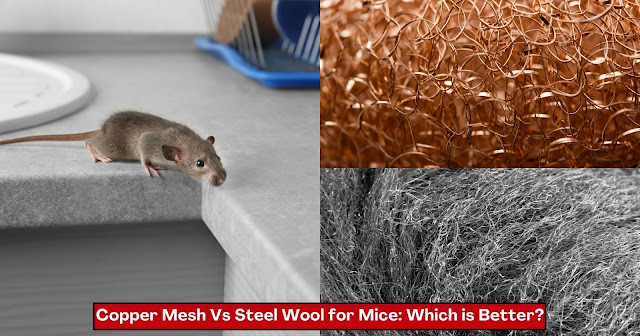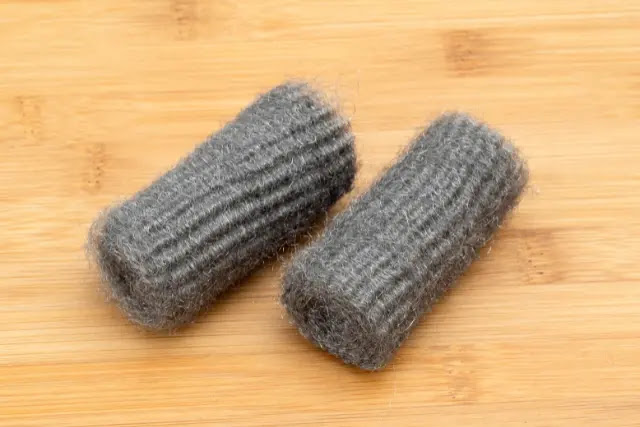Steel wool and copper mesh are both widely used materials in pest control, as they provide superior protection compared to other materials on the market today. These two materials have been studied extensively for their ability to keep out even very determined critters like rodents from entering into areas like walls or roofs where they could cause destruction or damage property. The strength of these metals ensures that mice can’t bite through them when looking for food sources. They also discourage any further efforts since no matter how much pulling and tugging takes place, the materials do not give way easily. We compare the two options to help you make a decision.
{tocify} $title={Table of Contents}
Copper Mesh as a Mouse Deterrent
Copper mesh is a highly effective rodent deterrent that has been used for many years. It is made from tightly woven, fine strands of copper wire and can be purchased in sheets, rolls, or pre-made tubes depending on the size and type of rodent you are trying to exclude. Copper mesh is very durable, corrosion-resistant, and virtually indestructible. It’s also non-toxic to people and pets, making it a safe alternative for pest control. Copper mesh is easy to install in a variety of different areas, such as holes or crevices around the house or in a garden area that might be conducive to mice infestation. The mesh acts like a barrier, preventing rodents from entering through any small gaps. Once installed, it will last indefinitely with no adverse effects on its effectiveness over time.
Advantages of Copper Mesh
- Durability and longevity: The higher tensile strength of copper mesh makes it a very durable and long-lasting material, perfect for high-use areas.
- Rust-resistant properties: The copper mesh is a great choice for mouse control because it has rust-resistant properties, meaning that it will not corrode and breakdown over time like traditional metal pest-exclusion materials
- Ability to block small openings effectively: The copper mesh is an effective way of blocking mouse entry since its small weave pattern prevents rodents from entering through even the smallest gaps. The flexibility and malleability of copper also make it easy to install in awkward spaces, such as inside cavities or cramped corners.
- Easy installation: The relatively lightweight nature of the copper mesh makes it very easy to install without much hassle. As one large sheet, there are no joint lines that require extra effort or adhesion, speeding up the process significantly.
Steel Wool as a Mouse Deterrent
Steel wool is a type of mesh made from alloy steel known as ‘iron low-carbon that is composed of fine strands of metallic wire. It has traditionally been used as a scouring pad in many industries, due to its abrasion and corrosion-resistant properties; but it also possesses some unique characteristics when used against mice. Its small holes can catch and hold rodent hairs, providing a sticky barrier that stops them from passing through or nesting around it. Unlike copper mesh or poultry netting which can bend easily under pressure from rodents, steel wool maintains its strong structure throughout; creating a more effective deterrent than other materials. Furthermore, for optimal effectiveness, all cracks and crevices should be filled with properly secured sections of steel wool once every 1-2 months. This ensures that potential water leakage does not cause rust damage over time.
Advantages of Steel Wool
- Abrasive material which can hinder rodent access: Steel wool is a very abrasive material, so it can physically block rodents from gaining access to an area.
- More durable than other alternatives: Due to its stronger, more durable structure, steel wool does not easily decompose over time and therefore provides longer-term effectiveness than some alternative deterrents.
- Can last up to 12 months when applied correctly: When properly placed and protected against weather conditions (e.g., rain), steel wool can serve as an effective mouse repellent for up to a year or more.
- Ability to be stuffed into any cracks or openings around the house easily: Steel wool in particular can be stuffed into stubborn areas around the home such as electrical outlets, plumbing fixtures, and even gaps in walls to create a physical deterrent to rodents trying to enter.
- Availability and affordability: Steel wool tends to be much less expensive than most other mouse deterrents, and it can be found at most home supply stores or online retail outlets.
Comparison Between Copper Mesh and Steel Wool
When it comes to deterring mice, some individuals might have a preference for copper mesh or steel wool. Both materials can be effective in keeping rodents at bay but several factors need to be taken into account when assessing which one is best for any particular situation.
Copper mesh is generally more effective due to its sharp edges although wear over time can cause these edges to become less distinct, diminishing the material’s efficiency as a deterrent for rodents. Steel wool on the other hand does not usually blunt with use making it an ideal long-term solution when you need permanent protection from pests such as mice.
Durability and longevity wise, both of these materials are quite sturdy so they will last for a decent amount of time providing they are installed properly. In most instances, regular maintenance using either copper or steel reinforcements should ensure that the material lasts for many years. Installation and application-wise, both copper mesh and steel wool are easy to install as they don’t require any special tools or skills making them ideal solutions for individuals wanting a simple solution to their mouse problem.
In terms of cost-effectiveness, steel wool is usually cheaper than copper mesh due to its abundance in hardware stores throughout most countries. Additionally, both options should be considered safe from an environmental perspective provided that they have been installed according to manufacturer instructions. Although caution must still be taken when handling either option as both materials pose potential health risks if not handled with care.
Overall, determining if copper mesh versus steel wool is better for mice depends on a person's specific situation taking into consideration factors such as effectiveness, durability, installation/application processes, and costs associated with usage, etc. Ultimately though, whichever one you choose will likely prove effective at reducing the impact rodents have on your home or business environment.
Will Mice Chew Through Steel Wool or Copper Mesh?
Mice are resourceful creatures that can chew through a variety of materials. Steel wool and copper mesh, which are both made with metal wires intertwined together, may cause mice to be deterred from passing through or chewing their way in due to the sharp edges used.
Although they will not be as easily chewed through as other softer materials like cardboard or wood, steel wool, and copper mesh do have the potential to be compromised with enough determination by a mouse.
Steel wool especially is known for being susceptible to damage by some rodents under certain situations. It deteriorates after long-term exposure to air and significantly loses its abrasiveness once wetted. This would provide easier passage for these tiny critters if they choose to press on regardless of hardship.
Using a sealant such as caulk or silicone on any holes can be an effective solution to keep mice from passing through the steel wool or copper mesh and protect it from becoming compromised. For extra assurance, some brands offer rodent-resistant models of these products which are designed with a slicker weave that interfere with mouse claws.
Practical Considerations and Recommendations
When deciding whether to choose copper mesh or steel wool to control mice, you should consider both the environment and storage conditions of your home. Copper is more expensive than steel wool but usually works better due to giving an electric shock when rodents come in contact with it. This makes copper a good option for places where pesticides can't be used. Additionally, copper holds up longer than steel wool so it will require less maintenance over time compared to other metal solutions -- while still needing occasional upkeep depending on environmental factors and moisture levels. Steel wool on the other hand may rust quickly which means that replacing it would become necessary sooner possibly making it overall costlier in the long run.
Conclusion
Ultimately, the choice between copper mesh and steel wool for mice control is a matter of personal preference. Copper mesh provides an effective long-term barrier since it is not easily compressed or chewed by rodents, while steel wool needs to be frequently checked and replaced as it can get flattened with use. Both materials offer a physical deterrent that can prevent entry into household spaces through small cracks and crevices. However, if you require stronger protection against aggressive rodent infestations then professional pest control products are recommended.



